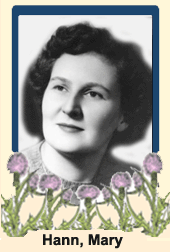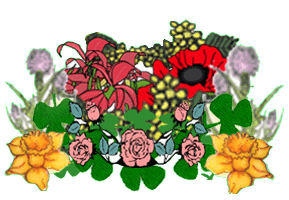Newfoundland War Brides
 |
 |
 |
August 2007 Lin Crosbie-Marshall |
www.downhomelife.com August 2007
The following story is an exerpt from the article "Of Love and War" from the August 2007 edition of the Downhome magazine. It is posted with the permission of the Downhome magazine and its author Lin Crosbie-Marshall. The original article has been divided into three parts and can be viewed separately on this web site in the "Stories" section under the names of the war brides Marion Hann, Mary Hann, Catherine Rowsell and Eileen Hamlyn.
Introduction
Lin Crosbie-Marshall discusses courtship and cultural connections with four Corner Brook women who left Scotland over 60 years ago, and followed their soldier husbands to western Newfoundland.
The bonds of love forged during wartime are often so strong they cannot be severed by time, distance, or even death. In the early 1940s, as bombs shattered the tranquility of Europe’s cities and countryside, love was busy blitzing its way into the hearts of four young men from Newfoundland and four young women from Scotland.
In the wake of the Second World War, nearly 50,000 brides from Great Britain followed their soldier husbands to Canada. Many came to this province and several from Scotland settled in western Newfoundland. Now, more than six decades later, Downhome spoke with four of these “war brides” in Corner Brook, who enjoy a common heritage and friend-ship cemented during their weekly Scottish dancing classes. Here, they share their wartime love stories and their memories of how they created new lives for themselves an ocean away from home.
Part I
Sisters Mary and Marion Mann
Today, Mary Hann (nee Mann) is still being courted by her soldier, Bill – she is the only one of the four who is not a widow. Her story is particularly special because it involves two sisters from Scotland marrying two brothers from Corner Brook.
Bill and Victor Hann left home on Mother’s Day, 1940, to join the Newfoundland Field 166th Regiment, Royal Artillery, in Lesmahagow, Scotland. While on leave and visiting their married sister in Glasgow, Bill and Victor were introduced to her child’s babysitters, Mary and Marion Mann, who lived across the street.
Asked whether it was love at first sight, Mary replies with a grin, “Well, it was for him.” Bill retorts playfully, “I met her on Tuesday and wanted to marry her on Wednesday morning. But like the prudent and cautious Scot she is, she made me wait two years.”
The couple became engaged on New Year’s Eve, 1941. For the occasion, Bill overstayed his leave by three days and suffered 21 days of field punishment as a result. Sixty-five years later, with a glance in Mary’s direction, he affirms, “I’d do it all over again.”
Mary and Bill married in Glasgow in 1942. Three months later, Bill and Victor were shipped off to North Africa. It was three years before the Mann sisters saw the Hann brothers again. When the war ended in 1945, Mary boarded the SS Bayano in Liverpool, England, and sailed to Canada to reclaim her husband. Dressed in warm Scottish tweeds, Mary arrived in Montreal’s sweltering July heat to be met by the ever-romantic Bill and “a great big bunch of roses which he threw, one by one, at me on the ship,” she recalls.
Meantime, the shy and quiet Victor returned to Scotland to resume courting Mary’s sister, Marion. They married in Scotland on January 4, 1947, and flew from London to Gander, Newfoundland, nine days later. Unlike her warmly dressed sister, Marion arrived in her new country wearing “her little hat and little shoes” to be greeted by “about 16 feet of snow,” and her train from Gander to Corner Brook was held up in Grand Falls until the tracks at the Gaff Topsails could be cleared. When she arrived in Corner Brook, Marion’s first impressions were of wooden sidewalks and mountains of snow.
Marion and Mary were warmly welcomed by their husbands’ family, and lived with them until they found permanent homes of their own. The sisters were more fortunate than some other war brides, who experienced misery and abject poverty in their adopted country. They had each other and a fairly comfortable lifestyle. Bill became a successful businessman, and Victor had a secure position with Bowater’s paper mill. Marion even became a local celebrity as the voice of radio personality Madame Melody, spokesperson for the Goodyear &
House department store. The sisters were also members of the Rose and Thistle Club, a group of English and Scottish war brides who met regularly.
Although busy raising five children, over the years Mary was able to make occasional trips to Scotland to stave off homesickness. Her sister Marion’s trips were less frequent, as she became what she calls “homesick in reverse” during a three-month visit home shortly after the death of her four-year-old daughter (a tragic event that led Marion and her friend, Edna Lee, to establish the Wonderland School for the mentally handicapped in Corner Brook). Marion and Victor soon had another child.
“I was pregnant at the time of the Confederation debate and everyone made bets on whether my child would be born a Newfoundlander or a Canadian,” Marion says. Her daughter, Linda, was born a Canadian on April 26, 1949.
Sadly, Marion lost her beloved soldier to cancer in 1997. “Ours was a true love story and I still miss him terribly,” she whispers softly.
...Four women and four stories of sacrifice, adaptation and, most of all, love. They can sum up their lives as Scottish war brides in Newfoundland with two words: No regrets.

| Yearbook | References | Citizenship | Photo Album | Links |
| Submit Info | Contact Us | Comments |